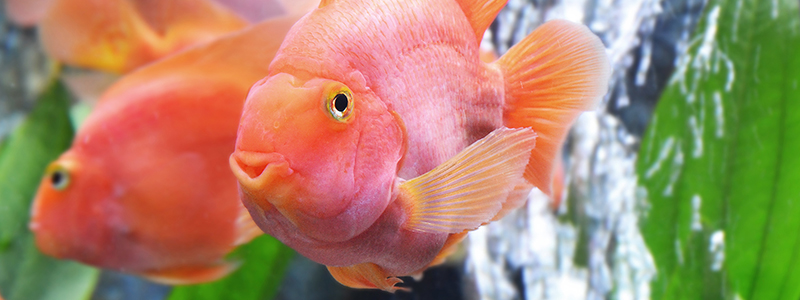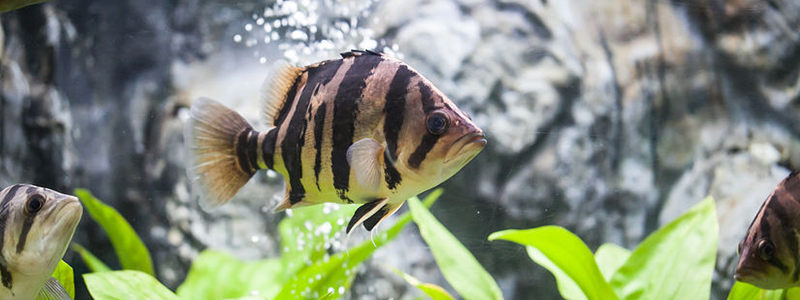| Family: | Characidae |
| Scientific Name: | Hemigrammus rhodostomus |
| Care Level: | Moderate |
| Temperament: | Peaceful |
| Diet: | Omnivore |
| Water Conditions: | Temp: 22°C – 27°C pH: 5.5 – 7.0 KH: 2 – 10. |
| Max Size: | 2 – 2.5 inches |
| Minimum Tank Size (as Adults): | 25 gallons |
Brief Overview: Rummy Nose Tetra Care
Scientifically known as the Hemigrammus rhodostomus, the Rummy Nose Tetra has different patterns and colors across its body. From its bright red head spot, slivery body to the fluke’s black and white stripes, this remarkable style mixture makes it an attractive fish that’s loved by many aquarists.
There are other similar species which are also called Rummy Nose Tetras. They include the Hemigrammus bleheri and the Petitella georgiae. They’re so identical that it would take a specialist with a trained eye to tell them apart. They might be similar, but they also have different requirements for their care.
Rummy Nose Tetra Lifespan: How Long Do Rummy Nose Tetra Live?
With proper handling, a healthy environment, and careful maintenance, the lifespan of the rummy nose tetra is around 5 to 6 years. Some exceptional specimens can live for almost a decade.
How Fast/Slow Should You Expect Rummy Nose Tetra to Grow?
It takes about six months for fry to grow into adult-size rummy nose tetras. Under the right temperature, nutrition, and care, the rummy nose tetra will eventually grow to about 2 inches.
What’s A Rummy Nose Tetra Max Size?
The maximum size that a rummy nose tetra can grow to is 2.5 inches.
The Firehead Rummy Nose species are usually a little shorter than the other two species and grow to be about 2 inches.
Different Types of Rummy Nose Tetra
The three species of the rummy nose tetra can be found in South America.
- The Hemigrammus rhodostomus: Also known as the true rummy nose tetra. This rummy-nose tetra is well-known and loved among aquarists. It grows to about 2 inches and was first discovered after World War I by Albert Ramsperger.
- The Hemigrammus bleheri: T In the wild, the Hemigrammus bleheri can be found in Brazil and Peru. It’s a quite popular aquarium fish and is also referred to as the Firehead Tetra. It was discovered in 1965 by Heiko Bleher. Unlike the true rummy nose
- The Petitella georgiae: The Petitella georgiae can also found in the Amazon Basin in Brazil and Peru. It is the sole member of its genus but has a striking resemblance to Hemigrammus rhodostomus and Hemigrammus bleheri. It was discovered in the late 1950s by H. Boutiere in Switzerland.
Rummy Nose Tetra Diet & Feeding
What Does Rummy Nose Tetra Eat in The Wild?
They’re omnivores and so, they would always go for small insects, tiny bits of plant debris, larvae or eggs while in the wild. As long as they fit into their mouths. However, you won’t find them feeding on live mosquito larvae and even if they do, it’s not quite common.
What foods are recommended for Rummy Nose Tetras?
To make sure that your rummy nose tetra is getting all the nutrients it needs, you can take advantage of flakes and food pellets. You can get plenty of these from stores to provide your pet fish with a diet similar to what it’s used to in the wild.
You can make use of flakes or pellets as its staple diet and then give additional treats once or twice per week.
For the sake of variety, live and frozen foods are good sources of protein. Rummy nose tetras will happily feed on Daphnia and bloodworms so they’re also good choices.
You can also add some spare green vegetables into their tank but make sure they’re chopped into tiny pieces.
As long as you’re feeding your tetras well, their color will develop properly.
Rummy Nose Tetra Fish Feeding habits
The rummy nose is not a picky eater. They love to consume a variety of meals. They do perfectly well with frozen, live and even artificial meals but it’s up to you to make sure that whatever you feed them with is of the highest level of quality and nutritional value.
Make sure you feed them twice a day as this will give them enough room to digest their food properly and only give them what they can finish in two minutes.
Rummy Nose Tetra Tank Setup
Brief Overview of Natural Habitat
The Hemigrammus rhodostomus lives in the Brazilian Rio Negro River, the Amazon River and the Rio-Vaupes River in Columbia in the wild. The rivers appear to have some kind of brown tint and are highly acidic due to the fallen plant leaves and organic materials that have decayed at the lake’s bottom.
Rummy Nose Tetras live in water bodies that are less inhabited by other fauna and that enjoy a canopy from the wide rainforest over them.
Although there are three rummy nose tetra species that live in different regions, they’re all used to the same conditions.
Now you may wonder, “How can I make my rummy nose tetra feel at home?”
- First, make sure that there’s a well-grained substrate at the tank’s bottom. This will emulate these species’ natural habitat. If you don’t want to go with sand, it’s okay to use gravel as well.
- Pick out plants and add them to the tank. Plants will serve as hiding spots for the tetras especially when they want to avoid other fishes or lights.
There’s no need for an air pump or even a water pump. The tank’s filter outlet will allow for the water’s stable movement, but if it’s a case of preference, you’re free to add as well. You can make use of aquarium lighting as they’ll always use the plants in the tank as a shelter when they want to hide away from the bright lights.
Rummy Nose Tetra Tank Size
Rummy nose tetras need at least a 25-gallon tank. Indeed, they’re small in size but these fishes love to have enough space to swim and form shoals as well. If you keep it in mind that you’ll be adding two gallons of water for each rummy nose tetra fish you add to the tank, you’ll find out that with a 25-gallon tank you can keep about 10 – 12 tetras. This will help to ensure that there’s enough space available for swimming and no overstocking.
Rummy Nose Tetra Water Conditions (Temperature, pH, KH)
You’ll need to add a heater to help maintain the water’s warm temperature. The range should be within 22°C – 27°C as this will match the temperature of tropical waters in the Amazon. Keep the pH levels between 5.5 -7.0 and the hardness shouldn’t exceed the KH of 2 – 10.
I’d advise that you also make use of an external water filter to help remove ammonia/nitrates from the water as rummy nose tetras are highly sensitive to these compounds.
Decorations
Decorations aren’t so necessary but if you want to add some, you’re free to. All you’ll need to do is to make sure that you leave enough space for swimming and not take up all the space.
Rummy Nose Tetra Tank Mates
Don’t add large fishes with big mouths or that have aggressive tendencies as they can end up eating your tetras. Apart from the threats they might pose to your pet tetras, large fishes can be very messy and end up making it difficult to maintain a healthy water environment.
Make sure you keep your rummy nose tetras in groups as they love living with their kind and are most active together, so buy about six. If kept alone, they’ll be easy prey for more boisterous fish and can become easily stressed.
When looking for compatible fishes as tank mates, consider these:
- Other Tetras
- Cherry Barbs
- Dwarf Gouramis
- Otocinculus
- Cory catfish
- Guppies
Rummy Nose General Behavior
Rummy nose tetras are quite peaceful and so, work great for community aquariums. They don’t go around troubling their tank mates but can be easily stressed by aggressive fishes.
They have no problems with other tetra species and they don’t like to be moved or changed to new locations. I already mentioned that they’re peaceful but they’re also delicate and so moving them has high tendencies of killing them or even making them lose their colorful appearance.
How to Keep Rummy Nose Healthy
Common Diseases to Look Out For
As long as your tank stays within the standard requirements, your pet fish will be most healthy. However, there are times that even when your best won’t be enough and then your rummy nose tetras will start getting sick.
The most common diseases that you should look out for are ich [also known as white spot disease] and dropsy [a situation where the fish swells up]. If these diseases thrive, a large fish population can be wiped off within a short period of time. Always check the rummy nose tetra’s color [especially the nose] as it becomes pale when the tetra is stressed or sick.
These diseases are usually a result of low-quality water and poor nutrition. You can clean up the tank and also purchase treatments for them if there’s no sign of recovery or improvement.
Tips on Keeping Rummy Nose Tetra in Good Health
Your tetras will become more prone to diseases if they don’t get enough nutrients from their food. You can stop this from happening by improving and balancing their diet.
Also, you must know how to clean out a water tank properly or make use of water filters as some of the diseases that affect these fishes spread easily through the water.
After feeding, get rid of food excesses to prevent the food from decaying in the tank and contaminating the water.
Breeding Rummy Nose Tetras
The major challenge with breeding is having a good mixture of both sexes. Since it’s quite difficult to tell their sex apart, I’ll advise that you confirm their sex with the help of a specialist when purchasing.
Warm the tank’s water to about 27°C and keep the water well filtered, this will help trigger breeding. Make sure you’ve added plenty of plants as this is where breeding happens.
Once the eggs have been released, separate them to prevent them from being eaten. After hatching, the fry won’t swim till after 6 days. Feed them with special foods up till they reach juvenile sizes before you give them the adult diet.
Interesting Facts About Rummy Nose Tetras
One interesting fact about the rummy nose tetras is that they can act as a “mine canary” in the aquarium. This helps to get your attention to deal with potential pollution problems in your aquarium.
Is A Rummy Nose Tetra the Right Choice for Your Aquarium?
Although a little experience is needed with rummy nose tetras, if it’s your first time, you just need to be very vigilant as they might not survive any mistakes you make. With that said, I’d like you to just remember a couple of things.
- Protect them from larger or boisterous fish species as tank mates.
- Keep the water in the tank clean at all times as they’re sensitive to water pollutants.
- Having a shoal will not only make your rummy nose tetras happy but it’ll make your aquarium come alive.
Once, you’ve done all these, you’ll find out that choosing a rummy nose tetra for your aquarium was a good choice.
Do you have questions or concerns? Let me know in the comment section below.





